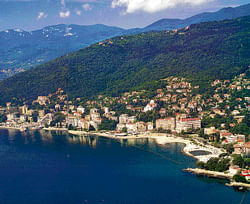Captivating Croatia


Once is never enough when it comes to savouring Croatia. Lying on the Adriatic coast, it is hard to believe this is a land wounded by a tumultuous past for centuries. Fortunately, no scars remain. Only vibrancy and joie-de-vivre. The landscape is resplendent with islands, churches, beaches and cliffs. The sun is particularly generous and Croatia is shining brighter than ever.
We arrived at Opatija, the town which was once the multi-cultural hub of the Austrian-Hungarian empire. Located in the Kvarner Riviera, it stretches around the foothills of Mount Ucka. Come summer or winter, it’s a tourist’s delight, thanks to its sub-tropical climates. Baroque style of architecture is etched on its villas and palaces. We met Prof Ante Stampalija from the Opatija tourism who acquainted us with the town and its cuisine. Opatija is indeed a hot destination in Europe with its 1185 islands. Its seaside promenade, parks and beaches are a hub of activity with yachtsmen, sunbathers and joggers.
Blessed with natural beauty
Opatija is also the gateway to Istria, which was our next stop and a secret, waiting to be explored. It is a winner every way. On one hand, you have the tranquillity of the inland and on the other, the proximity to the sea. The territory is laced with rich forests and studded with vineyards, olive trees, pastures and orchards. For seafood lovers, the catch is right here!
Ozren Grbavcic from the Istria Tourist Board took us to the hills dotted with medieval towns. One such town was Motovun. This was our tryst with the past. The fortification dated back to the 12th and 13th century. The historical coat of arms on the building facades and the Venetian influence in the form of the lion with the closed book were memorable. The cobblestone streets transported us from one century to another! Beneath the hills, there were villas and vacation houses. The surreal sylvan retreat.
Motovun was particularly blessed. With truffle rich forests, olive gardens, wild asparagus and vineyards. It was fascinating how truffle hunting is done with the help of specially trained dogs. “Truffles decide when it wants to be found,” Ozren informed us. No Istrian experience is complete without a date with its gastronomy. Which was why it was time for us to imbibe the art of tasting the extra virgin olive oil. We visited a traditional Istrian house, the Ipsa family olive plantation in Livade. Our hostess laid out the ‘Merenda’ (a mid-afternoon snack) comprising sardines, sun-dried tomatoes, figs, eggs with truffle and brushetta. This was countryside in its finest flavours.
Bicycle, wine and olive-oil treks are becoming increasingly popular here. We got on to the long winding roads which took us to the artists’ colony of Groznjan with its galleries, curio shops and studios. It was a close encounter with a town that had risen like the phoenix after surviving the bubonic plague, and much later after it was abandoned by Italian residents. As we moved on, the landscape kept changing and the coast got closer. At Porec, stood the Euphrasius Basilica, one of the most magnificent Byzantine churches in Europe. As the day drew to a close, we entered Rovinj, the traditional Venetian fishing port. The houses were built closely due to lack of space.
The streets were narrow and the chimneys unusual. And in the vast expanse of the blue sea, the yachts and smaller boats rubbed shoulders. As the sun set and dusk descended, there wasn’t a more poignant place to be in as in Rovinj.
Our final stop in Croatia was Zagreb. The railway station itself was beguiling. On the streets, the Gothic cathedrals stood tall. It didn’t take much to discover that all roads do not lead to Rome but to Ban Josip Jelacic Square, the city’s landmark. The greenery was in the shape of a horse shoe. We stopped at the Mandusevac Fountain and its wishing well. Busts of Croatian personalities towered the Zrinjevac Park. The blue trams zoomed past, and the Central Market was crowded.
A pharmacy caught our attention. It has been open for business since the 14th century. Interestingly, Niccolo Alighieri, grandson of Dante, worked here as pharmacist. St Mark’s Square with Church of St Mark and the muti-coloured tiles on its roof with the coats of arms came alive from the picture postcard. Soon, it was time to take a stroll on the Strossmayer Promenade…
Croatia is not all about walls and beaches. It is also about its people — simple, warm and hospitable. They are multi-lingual and proud of their heritage and of its coast and inland, which they call the blue and the green Mediterranean. A coast tough to leave even after you leave!
Deccan Herald is on WhatsApp Channels| Join now for Breaking News & Editor's Picks